The Proximity Effect in Twin Line with Round Conductors Placed in Conductive Medium
Abstract
1. Introduction
2. Methodology
2.1. The Configuration, Idea of Solving, and Outline of Research
- the wires are placed in a conductive medium, which extends theoretically to infinity,
- the material properties of the wires and the medium are constant,
- the displacement currents are neglected.
- what is the distribution of eddy currents density in conductor 2,
- how the skin depth parameters affect the eddy currents density,
- what is the influence of asymmetry in the conductors’ cross-sections,
- what is the influence of insulation thickness,
- how the results are affected in magnetic regions.
- the effect of environment conductivity,
- the dependence on frequency,
- the dependence on the distance between the wires.
2.2. Standalone Cylindrical Conductor in Conductive Medium
2.3. Cylindrical Conductor in Conductive Medium Near a Current Filament
- ,
- ,
- ,
- ,
- ,
- relative permeabilities .
2.4. Special Cases
2.5. Total Current Density
3. Results and Discussion
3.1. Comparison with FEM and BEM Results
- non-conductive and non-magnetic medium;
- non-magnetic conductive () medium;
- non-conductive magnetic () medium;
- conductive () and magnetic () medium.
3.2. The Influence of Various Parameters on Eddy Current Density
3.2.1. Current Density Distribution
3.2.2. The Effect of Skin Depth
3.2.3. The Effect of Size Asymmetry
3.2.4. The Effect of Insulation Thickness
3.2.5. The Effect of The Magnetic Medium
3.3. Symmetrical Twin Line—Numerical Results and Discussion
3.3.1. Comparison with FEM and BEM
3.3.2. The Effect of Environment Conductivity and The Gap between The Wires
3.3.3. The Effect of Frequency and Conductivity of The Medium
3.4. Implications
3.5. Limitations and Error Estimation
4. Conclusions
- The eddy currents density in the round conductors placed in the non-magnetic conductive medium is decreased compared to the same conductor in the non-conductive and non-magnetic medium due to the screening effect of the medium. This results in decreasing the proximity effect.
- If the conductors are placed in the magnetic and non-conductive medium, the proximity effect is enlarged.
- For the conductive and magnetic medium, the proximity effect is decreased in a larger degree compared to the case of a non-magnetic medium of the same conductivity.
- For copper conductors placed in soil or sea water, the change in current density distribution is very small, usually below 0.01%.
- Further investigations can be focused on tubular conductors and groups of conductors as well as on their impedances; also the boundaries of the medium can be taken into account.
Author Contributions
Funding
Conflicts of Interest
Appendix A
References
- Maxwell, J.C. A Treatise of Electricity and Magnetism; McMillan and Co.: London, UK, 1873; Volume II, Article 689. [Google Scholar]
- Manneback, C. An integral equation for skin effect in parallel conductors. J. Math. Phys. 1922, 1, 123–146. [Google Scholar] [CrossRef]
- Dwight, H.B. Proximity effect in wires and thin tubes. Trans. Am. Inst. Electr. Eng. 1923, 42, 850–859. [Google Scholar] [CrossRef]
- Tegopoulos, J.A.; Kriezis, E.E. Eddy current distribution in cylindrical shells of infinite length due to axial currents. Part I: Shells of one boundary. IEEE Trans. Power Appar. Syst. 1981, 90, 1278–1286. [Google Scholar] [CrossRef]
- Tegopoulos, J.A.; Kriezis, E.E. Eddy current distribution in cylindrical shells of infinite length due to axial currents. Part II: Shells of finite thickness. IEEE Trans. Power Appar. Syst. 1981, 90, 1287–1294. [Google Scholar] [CrossRef]
- Piątek, Z. Method of calculating eddy currents induced by the sinusoidal current of the parallel conductor in the circular conductor. ZN Pol. Śl. Elektr. 1981, 75, 137–150. [Google Scholar]
- Piątek, Z. Self and mutual impedances of a finite length gas-insulated transmission line (GIL). Electr. Power Syst. Res. 2007, 77, 191–201. [Google Scholar] [CrossRef]
- Piątek, Z. Impedances of Tubular High Current Busducts; Polish Academy of Sciences: Warsaw, Poland, 2008.
- Filipović, D.; Dlabač, T. Closed Form Solution for the Proximity Effect in a Thin Tubular Conductor Influenced by a Parallel Filament. Serb. J. Electr. Eng. 2010, 7, 13–20. [Google Scholar]
- Dlabač, T.; Filipović, D. Integral equation approach for proximity effect in a two-wire line with round conductors. Tech. Vjesn. 2015, 22, 1065–1068. [Google Scholar] [CrossRef]
- Jabłoński, P. Cylindrical conductor in an arbitrary time-harmonic transverse magnetic field. Przegląd Elektrotech. 2011, 87, 49–53. [Google Scholar]
- Rolicz, P. Eddy currents generated in a system of two cylindrical conductors by a transverse alternating magnetic field. Electr. Power Syst. Res. 2009, 79, 295–300. [Google Scholar] [CrossRef]
- Jabłoński, P. Approximate BEM analysis of time-harmonic magnetic field due to thin-shielded wires. Pozn. Univ. Technol. Acad. J. Electr. Eng. 2012, 69, 57–64. [Google Scholar]
- Piątek, Z.; Baron, B.; Jabłoński, P.; Kusiak, D.; Szczegielniak, T. Numerical method of computing impedances in shielded and unshielded three-phase rectangular busbar systems. Prog. Electromagn. Res. B 2013, 51, 135–156. [Google Scholar] [CrossRef][Green Version]
- Coufal, O. Current density in two solid parallel conductors and their impedance. Electr. Eng. 2014, 96, 287–297. [Google Scholar] [CrossRef]
- Freitas, D.; das Neves, M.G.; Almeida, M.E.; Machado, V.M. Evaluation of the Longitudinal Parameters of an Overhead Transmission Line with Non-Homogeneous Cross Section. Electr. Power Syst. Res. 2015, 119, 478–484. [Google Scholar] [CrossRef]
- Riba, J.R. Calculation of AC to DC resistance ratio of conductive nonmagnetic straight conductors by applying FEM simulations. Eur. J. Phys. 2015, 36, 055019. [Google Scholar] [CrossRef][Green Version]
- Capelli, F.; Riba, J.R. Analysis of Equations to calculate the AC inductance of different configurations of nonmagnetic circular conductors. Electr. Eng. 2017, 99, 827–837. [Google Scholar] [CrossRef]
- Riba, J.R.; Capelli, F. Calculation of the inductance of conductive nonmagnetic conductors by means of finite element method simulations. Int. J. Electr. Educ. 2018, 13, 230–252. [Google Scholar]
- Pagnetti, A.; Xemard, A.; Pladian, F.; Nucci, C.A. An improved method for the calculation of the internal impedances of solid and hollow conductors with inclusion of proximity effect. IEEE Trans. Power Deliv. 2012, 27, 2063–2072. [Google Scholar] [CrossRef]
- Jabłoński, P.; Szczegielniak, T.; Kusiak, D.; Piątek, Z. Analytical-numerical solution for the skin and proximity effects in two parallel round conductors. Energies 2019, 12, 3584. [Google Scholar] [CrossRef]
- Benato, R.; Paoluci, A. EHV AC Undergrounding Electrical Power. Performance and Planning; Springer: London, UK, 2010. [Google Scholar]
- Katsube, T.J.; Klassen, R.A.; Das, Y.; Ernst, R.; Calvert, T.; Cross, G.; Hunter, J.; Best, M.; DiLabio, R.; Connell, S. Prediction and validation of soil electromagnetic characteristics for application in landmine detection. In Detection and Remediation Technologies for Mines and Mine Like Targets VIII. Proceedings of SPIE Vol. 5089, AeroSense 2003, Orlando, FA, USA, 11 September 2003; Harmon, R.S., Holloway, J.H., Jr., Broach, J.T., Eds.; Society of Photo-Optical Instrumentation Engineers (SPIE): Washington, DC, USA, 2003; pp. 1219–1230. [Google Scholar] [CrossRef]
- Zdeb, M.; Papciak, D.; Zamorska, J. An assessment of the quality and use of rainwater as the basis for sustainable water management in suburban areas. E3S Web Conf. 2018, 45, 00111. [Google Scholar] [CrossRef]
- Tyler, R.H.; Boyer, T.P.; Minami, T.; Zweng, M.M.; Reagan, J.R. Electrical conductivity of the global ocean. Earth Planets Space 2017, 69, 156. [Google Scholar] [CrossRef] [PubMed]
- Pollaczek, F. Über das Feld einer unendlich langen wechsel-stromdurchflossenen Einfachleitung. Elektr. Nachr. Tech. 1926, 3, 339–360. [Google Scholar]
- Machado, V.M.; da Silva, J.F.B. Series-impedance of underground transmission systems. IEEE Trans. Power Deliv. 1988, 2, 417–424. [Google Scholar] [CrossRef]
- Machado, V.M.; da Silva, J.F.B. Series-impedance of underground cable systems. IEEE Trans. Power Deliv. 1988, 3, 1334–1340. [Google Scholar] [CrossRef]
- Tsiamitros, D.A.; Christoforidis, G.C.; Papagiannis, G.K.; Labridis, D.P.; Dokopoulos, P.S. Earth conduction effects in systems of overhead and underground conductors in multilayered soils. IEEE Proc. Gener. Transm. Distrib. 2006, 153, 291–299. [Google Scholar] [CrossRef]
- Yin, Y.; Dommel, H.W. Calculation of frequency-dependent impedances of underground power cables with finite element method. IEEE Trans. Magn. 1989, 25, 3025–3027. [Google Scholar] [CrossRef]
- Machado, V.M. FEM/BEM hybrid method for magnetic field evaluation due to underground power cables. IEEE Trans. Magn. 2010, 46, 2876–2879. [Google Scholar] [CrossRef]
- Machado, V.M.; Almeida, M.E.; das Neves, M.G. Accurate magnetic field evaluation due to underground power cables. Eur. Trans. Electr. Power 2009, 19, 1153–1160. [Google Scholar] [CrossRef]
- Budnik, K.; Machczyński, W. Magnetic field of underground cables. Elektryka 2010, 3, 7–17. [Google Scholar]
- Brito, A.I.; Machado, V.M.; Almeida, M.E.; das Neves, M.G. Skin and Proximity Effects in the Series-Impedance of Three-Phase Underground Cables. Electr. Power Syst. Res. 2016, 130, 132–138. [Google Scholar] [CrossRef]
- Moon, P.; Spencer, D.E. Foundations of Electrodynamics; David Van Nostrand Company, Inc.: New York, NY, USA, 1960. [Google Scholar]
- Gradshteyn, I.S.; Ryzhik, I.M. Tables of Integrals, Sums, Series and Products, 17th ed.; Elsevier Academic Press: Cambridge, MA, USA, 2007. [Google Scholar]
- Abramowitz, M.; Stegun, I.A. Handbook of Mathematical Functions with Formulas, Graphs, and Mathematical Tables; Applied Mathematics Series 55; National Bureau of Standards: Washington, DC, USA, 1972.


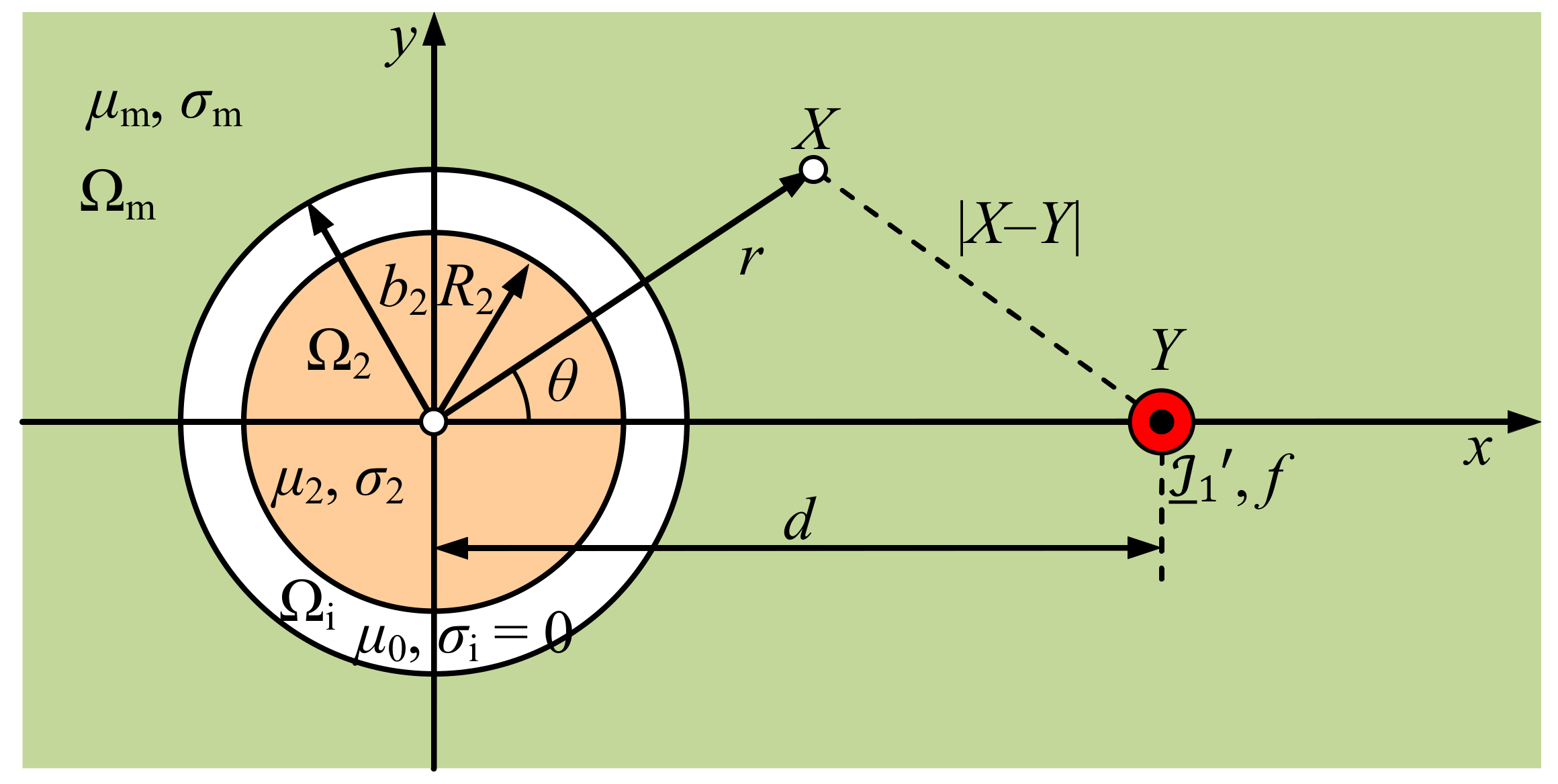
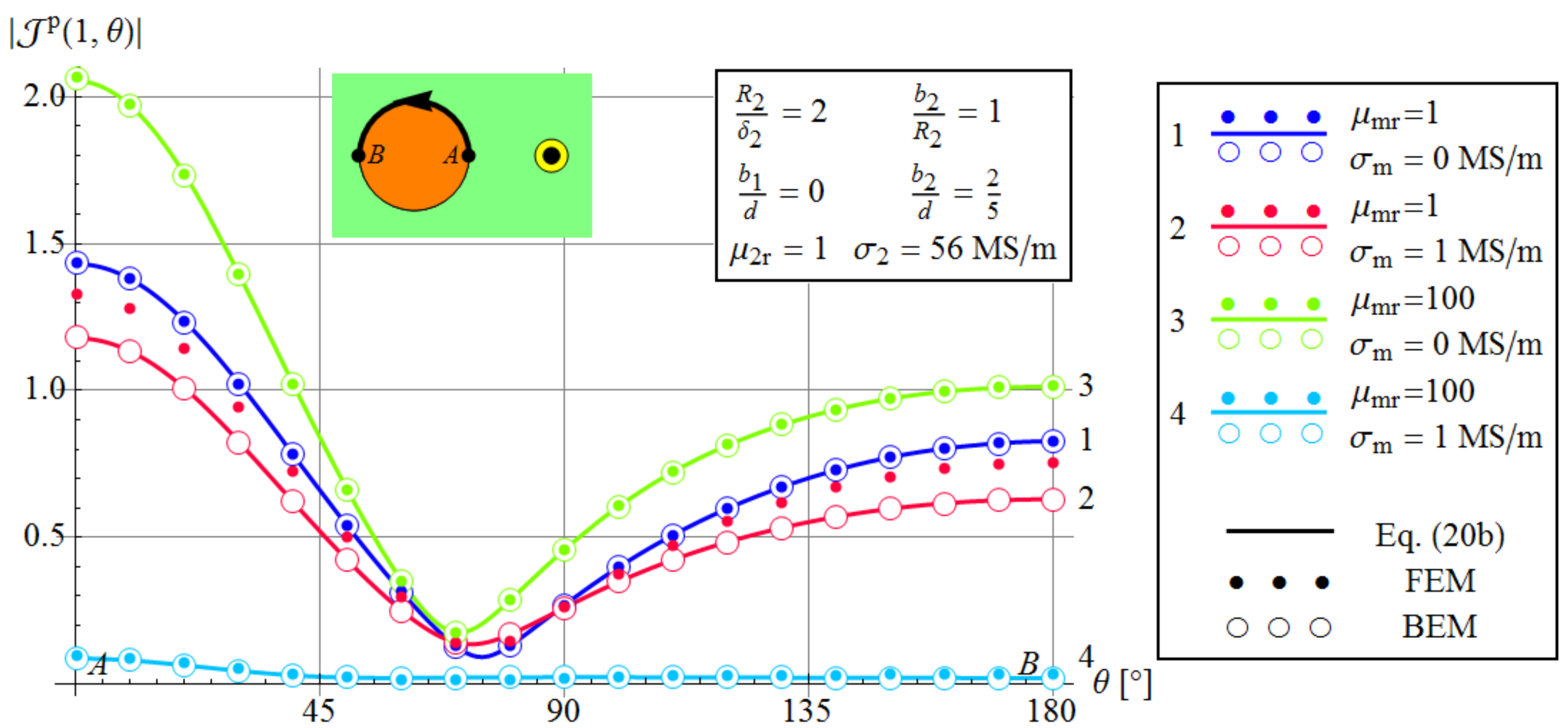
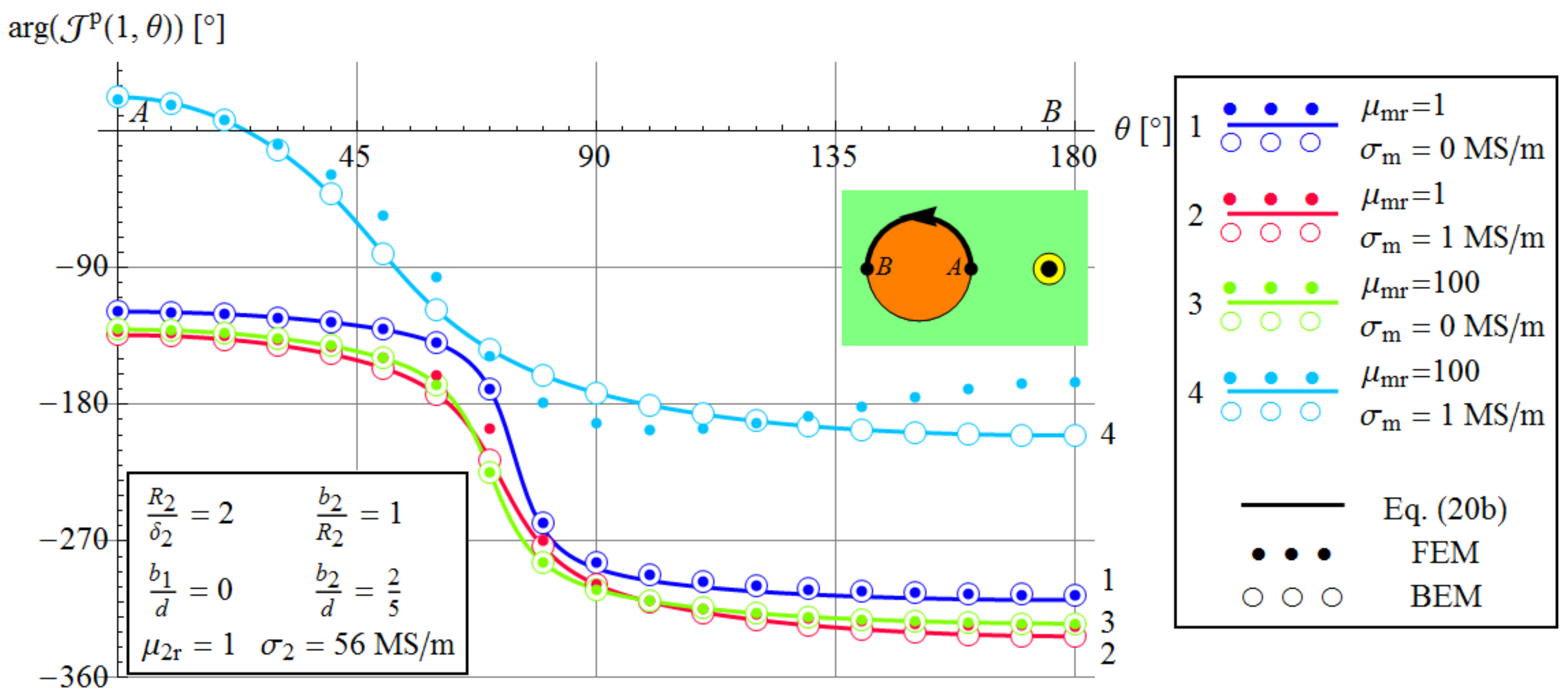

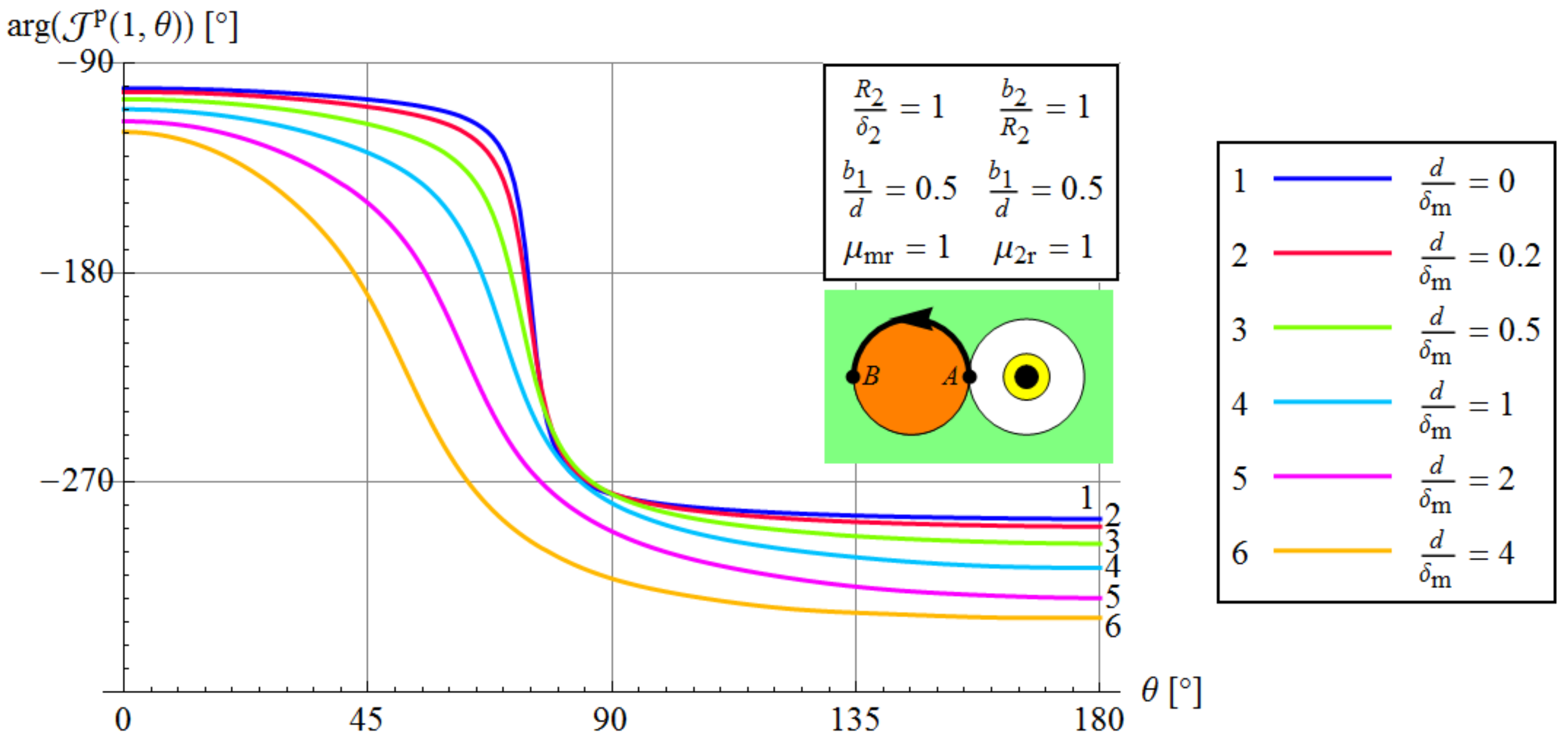
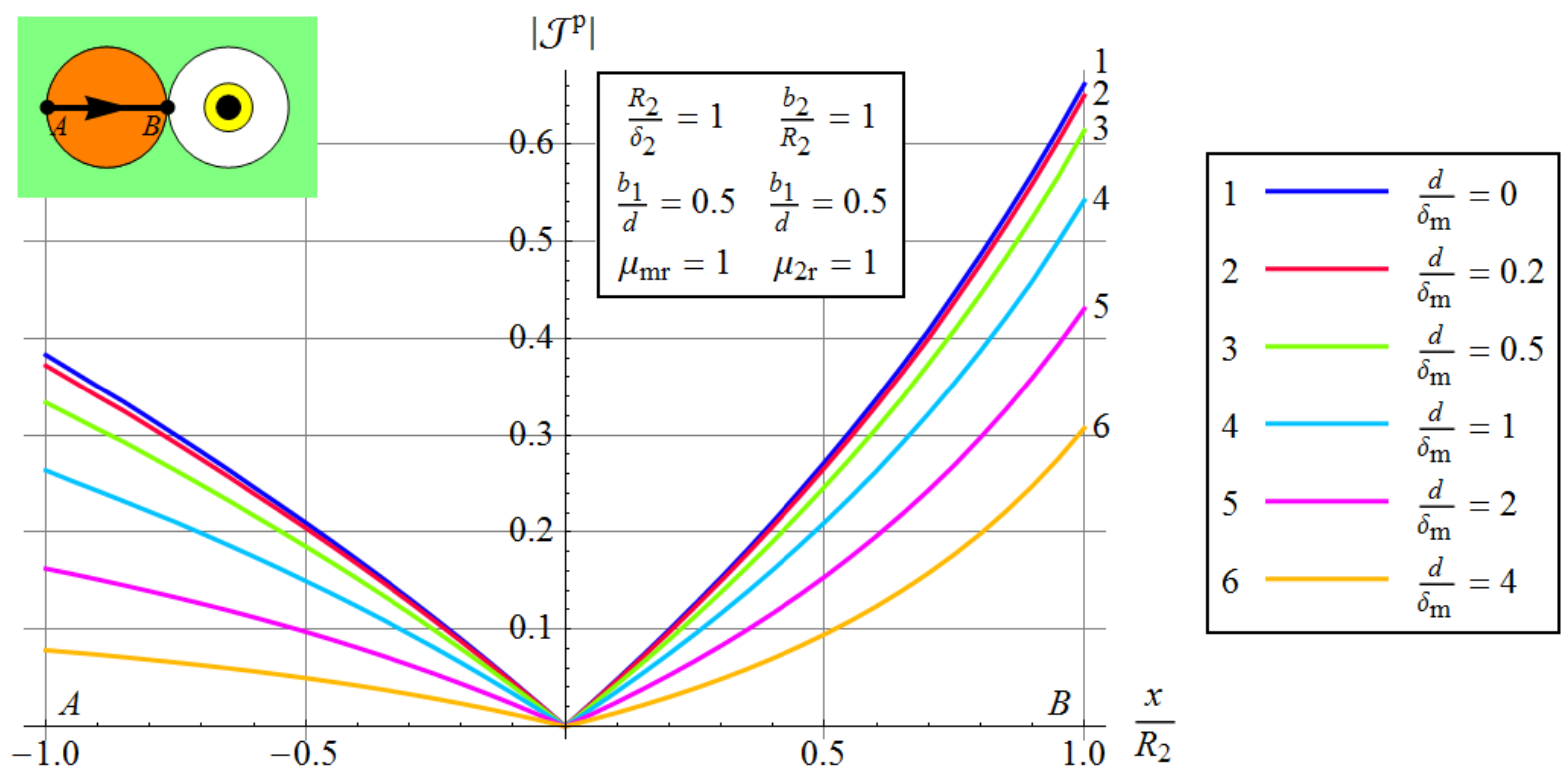
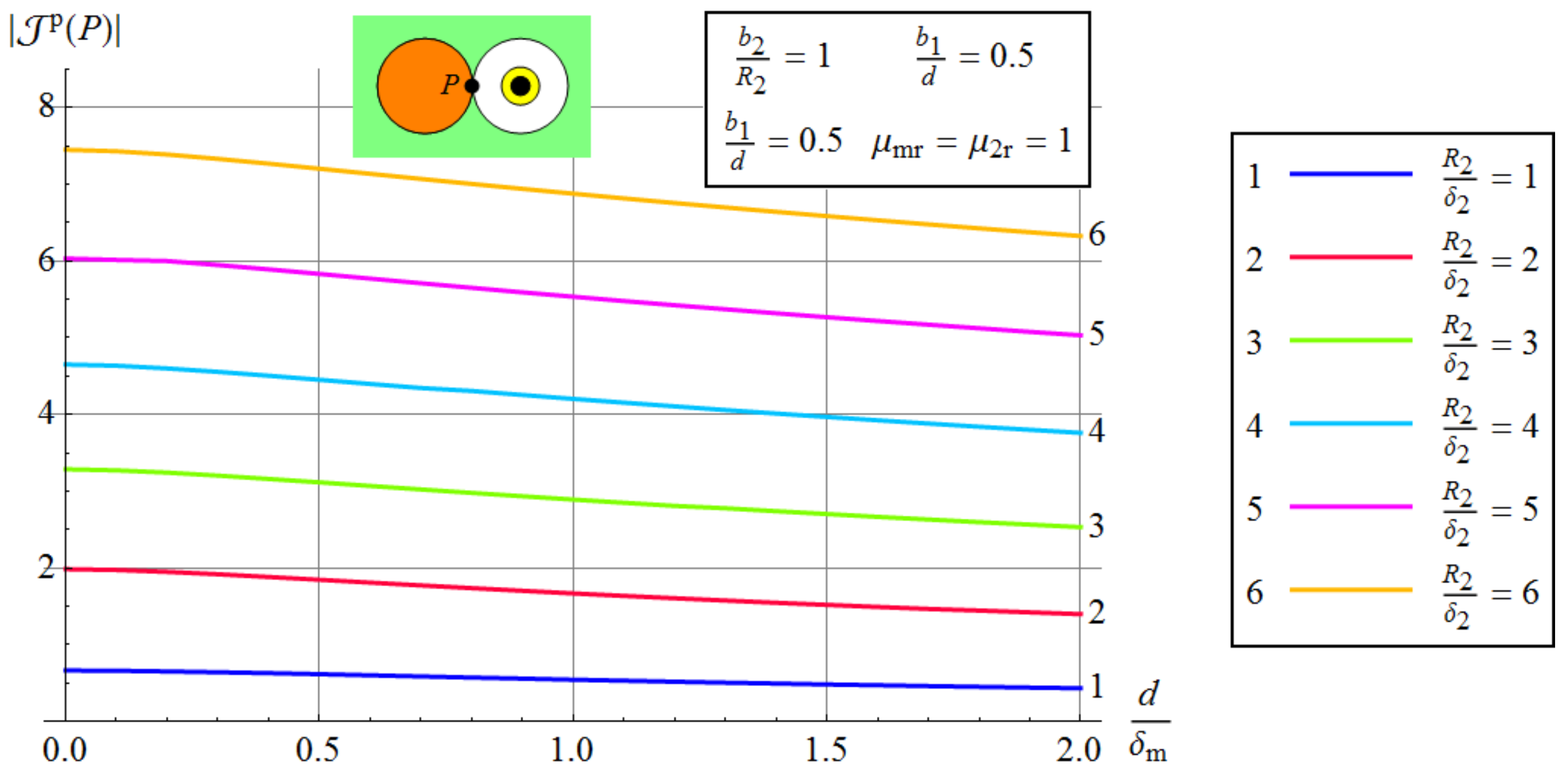
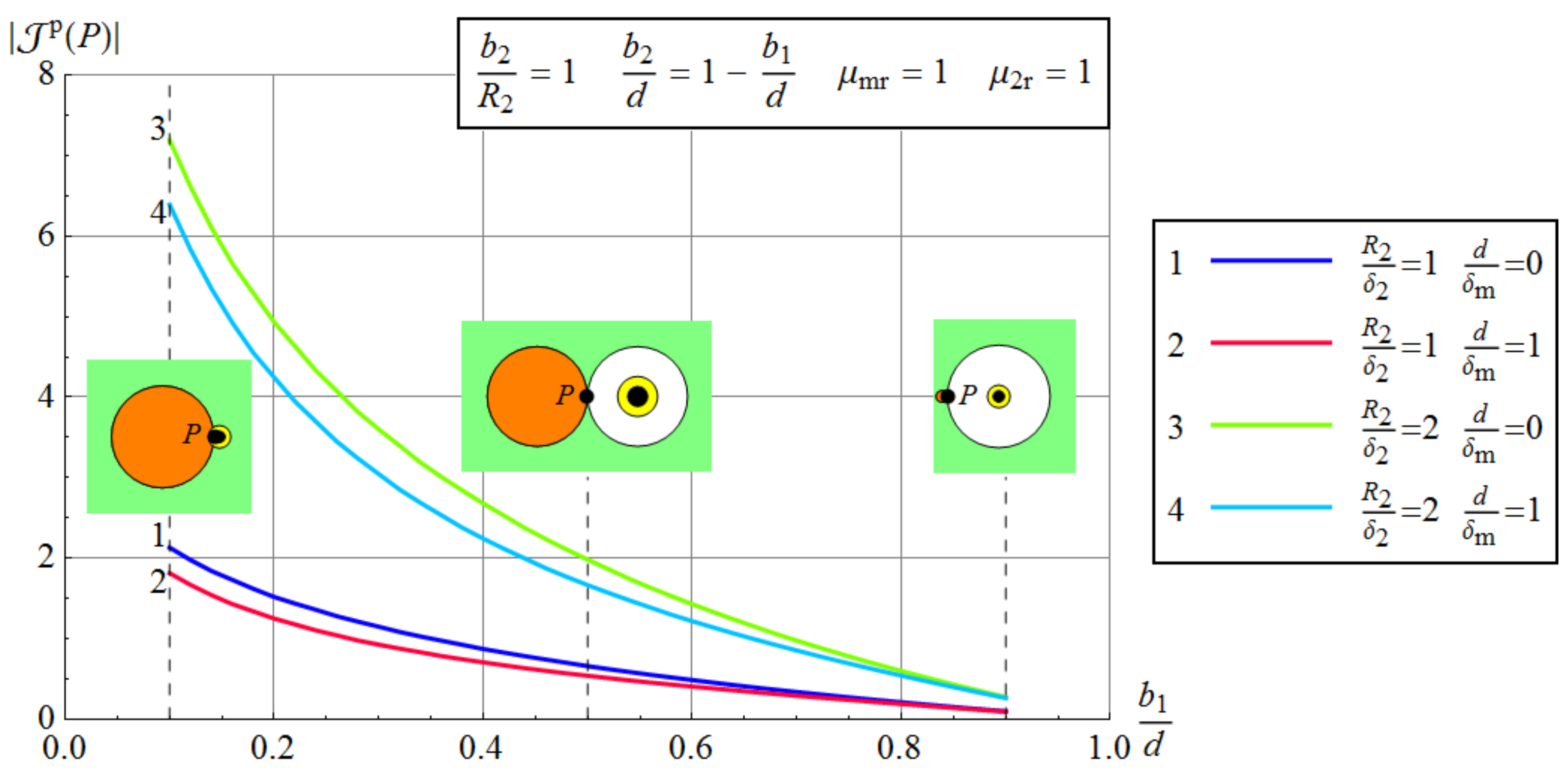
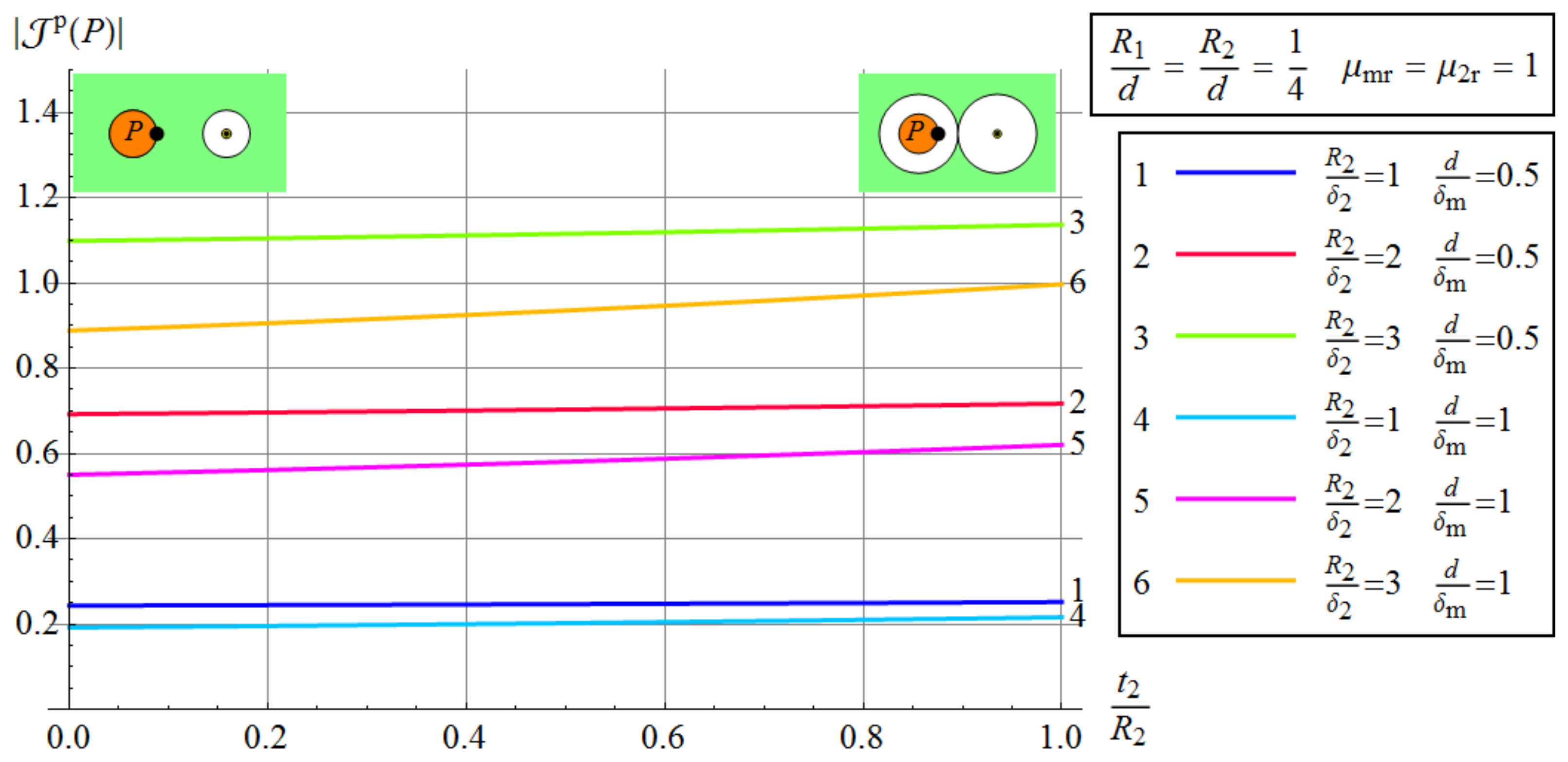


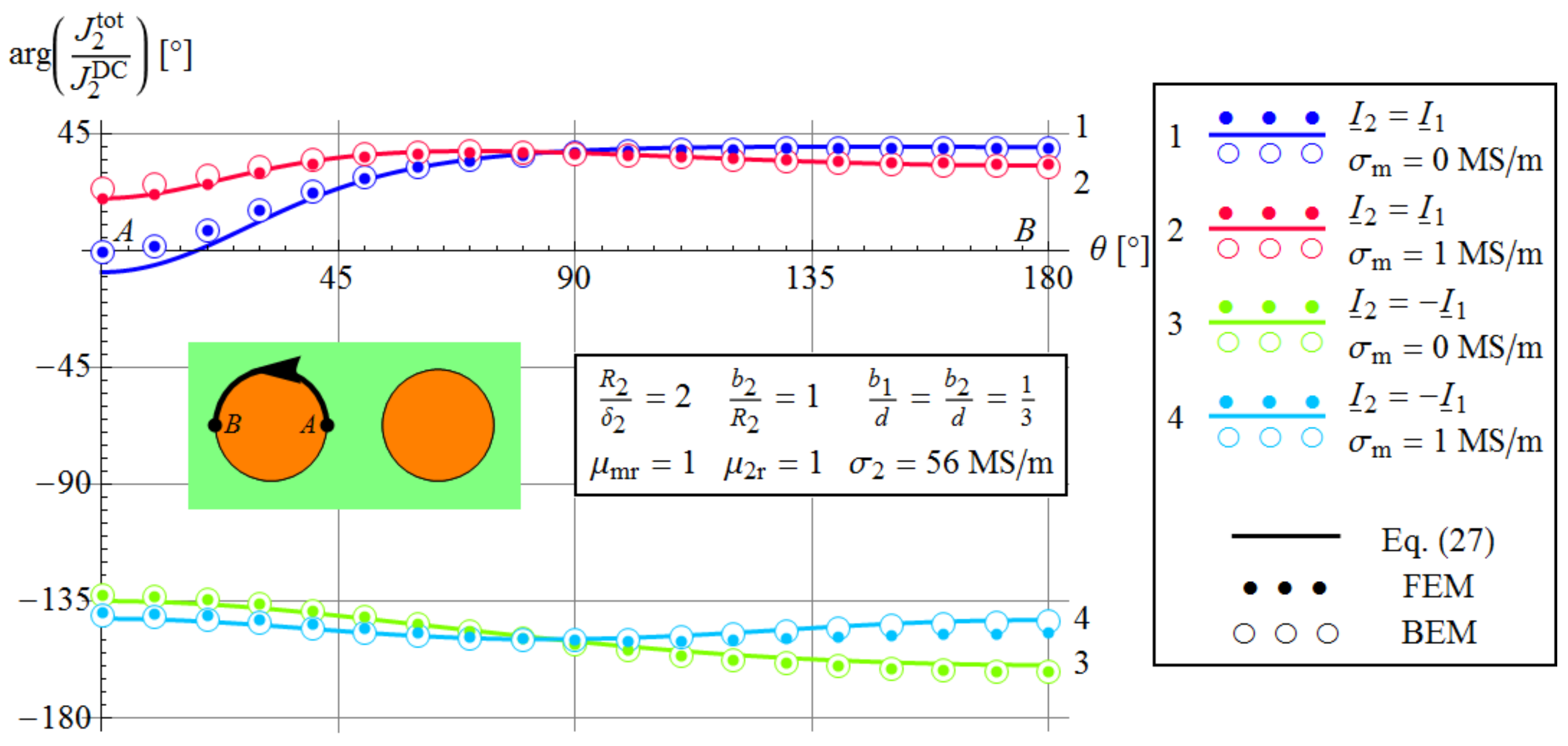
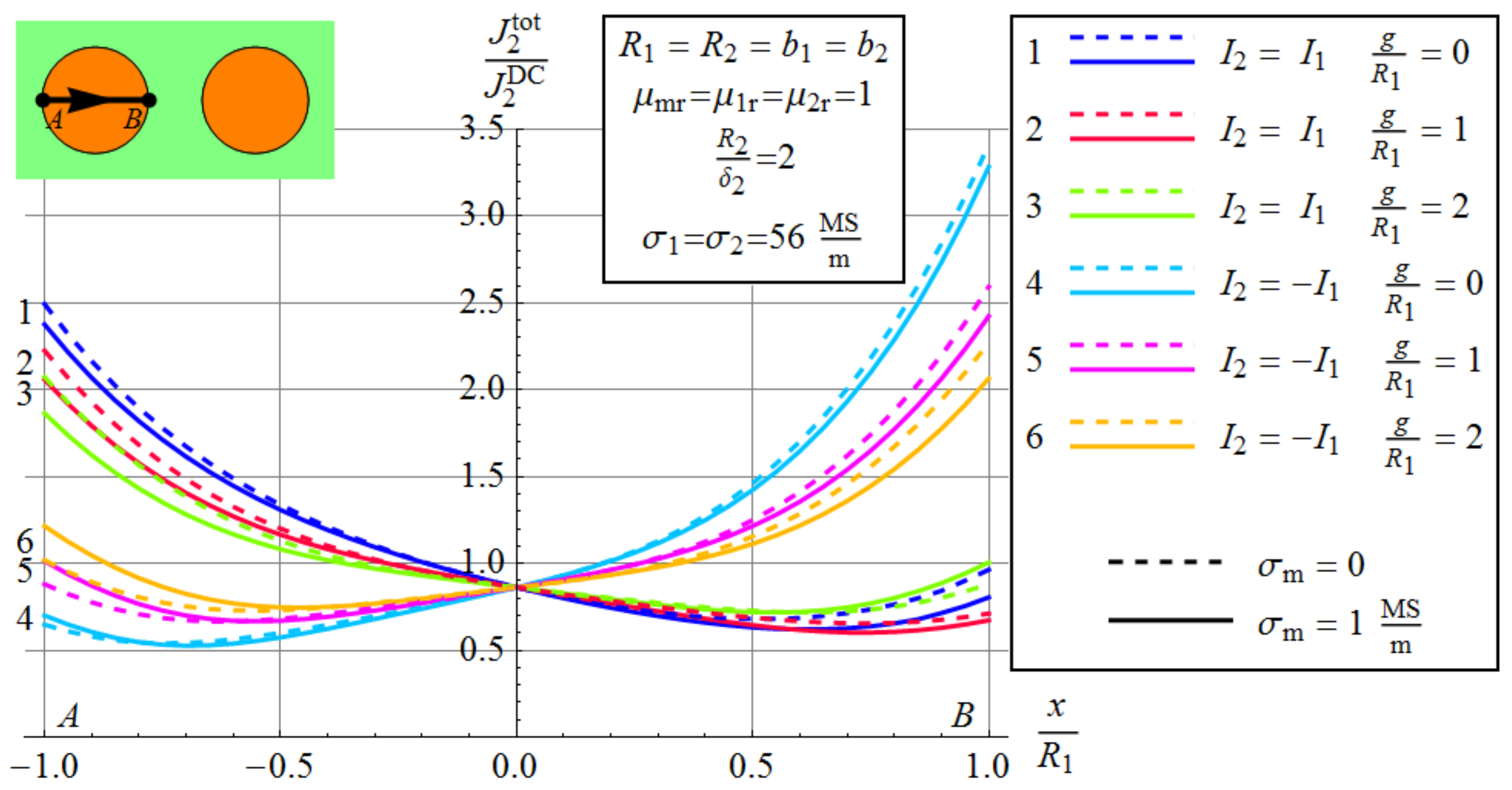
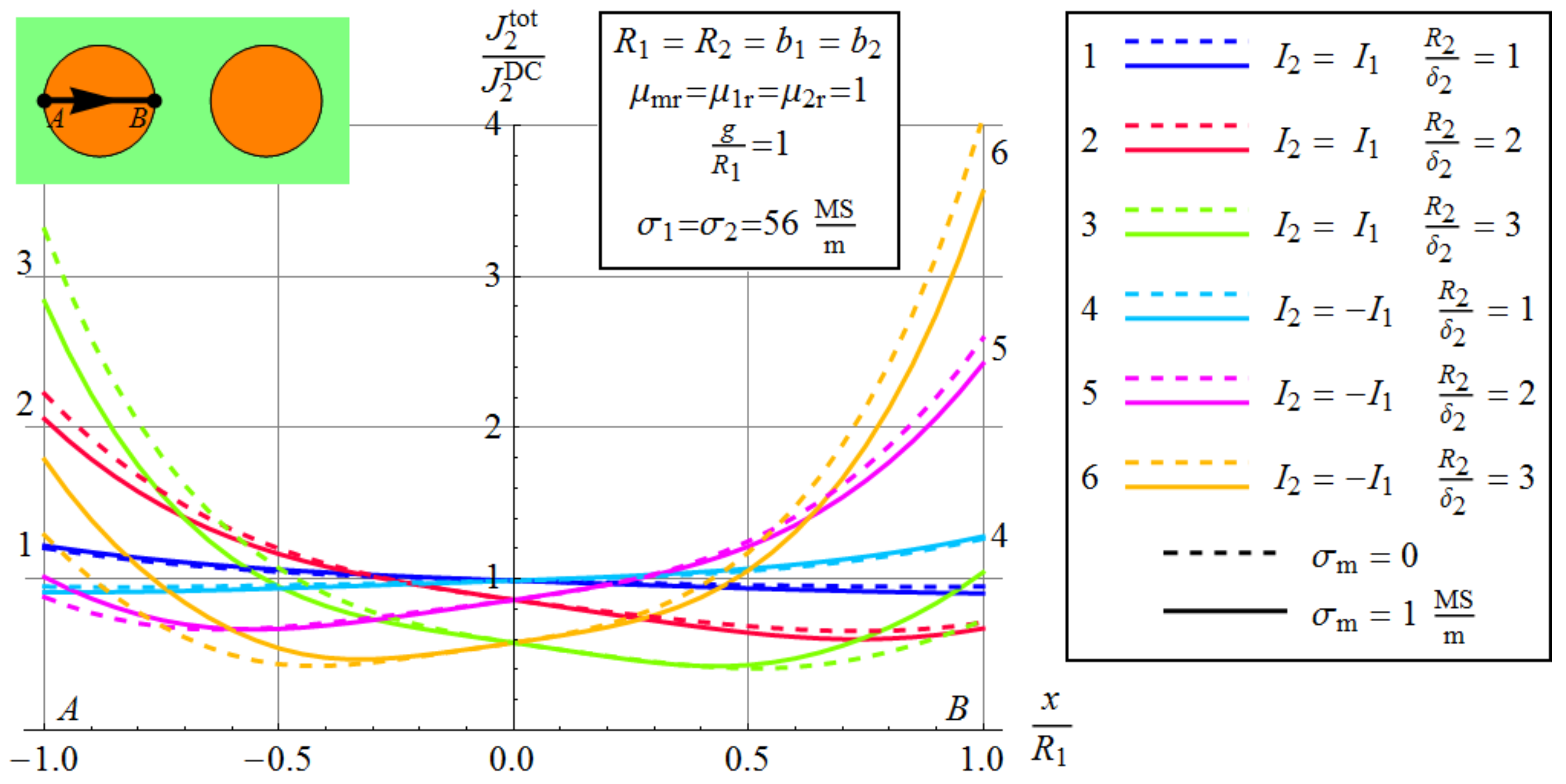


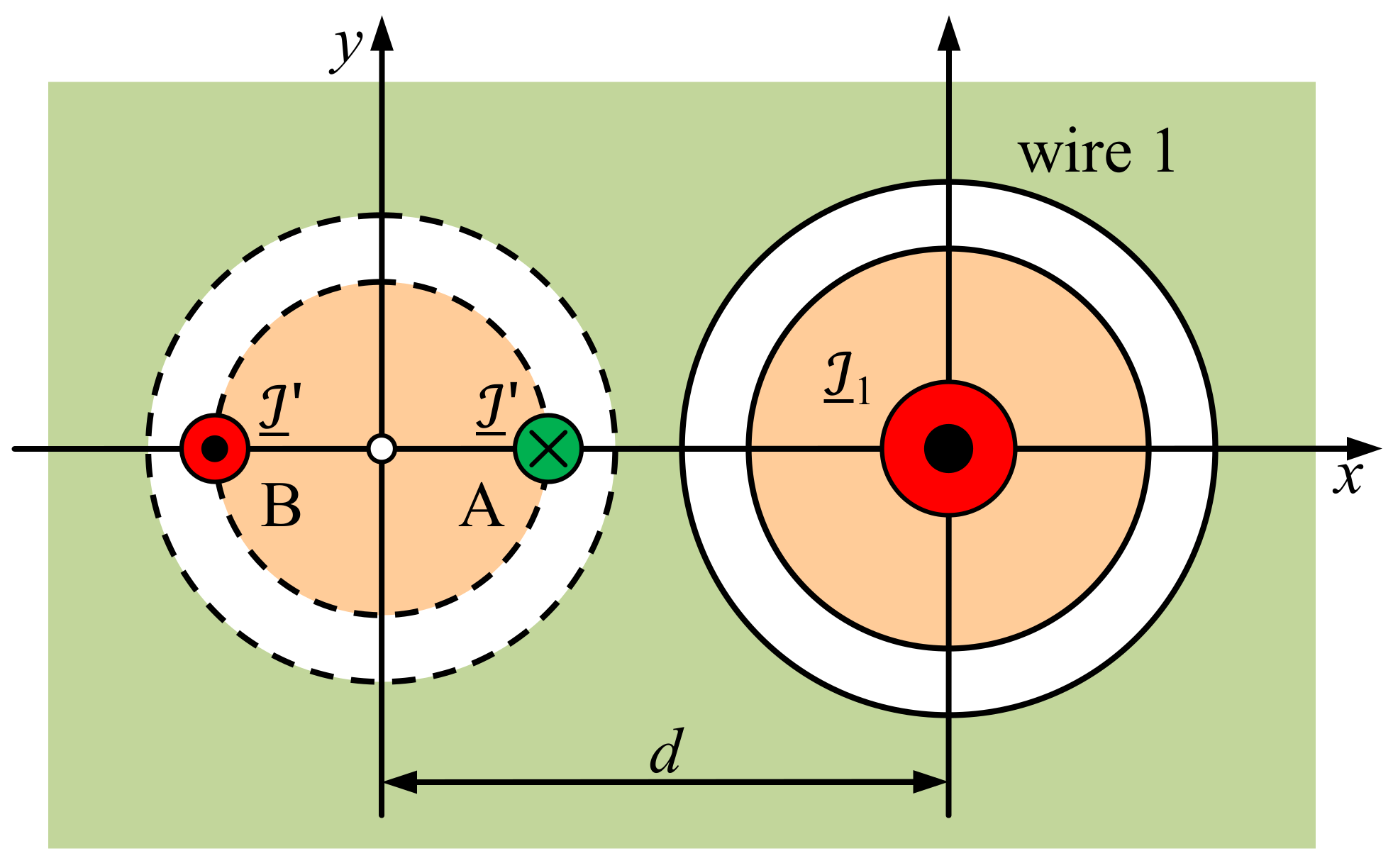

Publisher’s Note: MDPI stays neutral with regard to jurisdictional claims in published maps and institutional affiliations. |
© 2020 by the authors. Licensee MDPI, Basel, Switzerland. This article is an open access article distributed under the terms and conditions of the Creative Commons Attribution (CC BY) license (http://creativecommons.org/licenses/by/4.0/).
Share and Cite
Jabłoński, P.; Kusiak, D.; Szczegielniak, T.; Piątek, Z. The Proximity Effect in Twin Line with Round Conductors Placed in Conductive Medium. Energies 2020, 13, 6087. https://doi.org/10.3390/en13226087
Jabłoński P, Kusiak D, Szczegielniak T, Piątek Z. The Proximity Effect in Twin Line with Round Conductors Placed in Conductive Medium. Energies. 2020; 13(22):6087. https://doi.org/10.3390/en13226087
Chicago/Turabian StyleJabłoński, Paweł, Dariusz Kusiak, Tomasz Szczegielniak, and Zygmunt Piątek. 2020. "The Proximity Effect in Twin Line with Round Conductors Placed in Conductive Medium" Energies 13, no. 22: 6087. https://doi.org/10.3390/en13226087
APA StyleJabłoński, P., Kusiak, D., Szczegielniak, T., & Piątek, Z. (2020). The Proximity Effect in Twin Line with Round Conductors Placed in Conductive Medium. Energies, 13(22), 6087. https://doi.org/10.3390/en13226087





